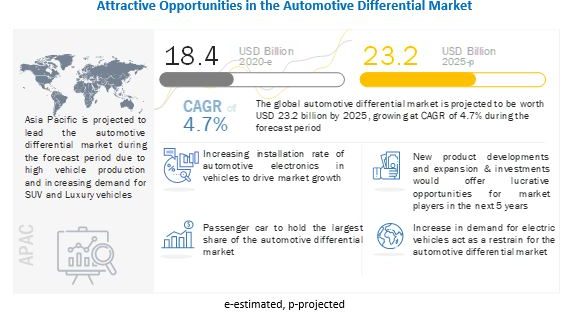
The automotive differential market is estimated to grow from $20.0 billion in 2022 and reach $23.7 billion by 2027, at a CAGR of 3.5%.
The automotive differential market growth is influenced by factors such as the demand for SUVs/MUVs & premium cars and an increase in preference for AWD/4WD vehicles. Rising per capita disposable income and growing standard of living have noticed the shift to SUVs and premium vehicles with 4WD/AWD. Presently, the open differential is occupying the largest share as it costs lower compared to other types. However, with advancement in technology and need for better driving experience, the demand for electronic limited slip differential (e-LSD) and torque vectoring would grow in near future.
Download PDF Brochure @ https://www.marketsandmarkets.com/pdfdownloadNew.asp?id=57980081
AWD/4WD is estimated to be the largest growing segment for automotive differentials
AWD/4WD is estimated to be the largest and fastest-growing market for automotive differential during the forecast period. The AWD/4WD differential demand is mainly driven by growing demand for full-size SUVs, crossovers, and premium sedan cars. Full-size SUVs had grown in recent years as Asia Pacific increased by 2.5% from 2018 to 2021 and globally, it is expected to grow at a CAGR of 6.7% during 2022-2027. The Americas holds the largest market share in full-size SUV and Europe would be the fastest growing market at a CAGR of 8.1% for full-size SUVs These vehicle types are expected to offer improved vehicle safety, stability, and enhanced driving dynamics during rainy, snowy, muddy, and off-roading terrains and hence, are equipped with AWD/4WD systems. The AWD/4WD systems use two differentials – front and rear and hence, demand for differentials will increase with the growing demand for AWD/4WD vehicles. Further, the rising adoption of 4X4, 6X4 drive configuration in light duty and heavy commercial trucks in Europe and Americas region would create the demand for differential in coming years.
Electronically controlled limited-slip differential (ELSD) is estimated to showcase the fastest growth in the automotive differential market
The Electronically Controlled Limited Slip Differential (ELSD) is seeing a greater adoption rate owing to its better efficiency, unlike mechanical differentials. It provides better tractability and stability while cornering and delivers high torque requirements for large passenger vehicles. However, electronic limited slip differential is costlier than other types of differentials. Hence, as of now it has less penetration and ELSD is limited to premium car segments owing to high price. Some recent developments have been carried out in terms of design that allows enhanced driving experience even in high-performance settings without adding much cost. For instance, ELSD technology developed by Dana Inc. offers superior performance and does not add cost against open differential units installed in two-wheel drive vehicles. Thus, considering above aforementioned benefits of ELSD, growing demand of premium cars and rising R&D efforts to minimize the cost so can be used in lower price range vehicles, which would create the demand for ELSD in near future.
“Asia Pacific would be the largest market for automotive differentials.”
Asia Pacific has witnessed significant year-on-year growth in the automotive differential market. Asia Pacific holds the presence of leading automobile and automotive component manufacturers and hosts manufacturing plants of major OEMs such as Honda Motor Co., Ltd (Japan), Tata Motors Ltd (India), Toyota Motor Corporation (Japan), BYD Motors (China), Mitsubishi Motor Corporation (Japan), Suzuki Motor Corporation (Japan), and Subaru Corporation (Japan). Additionally, the rising rate of car ownership in China, India, Japan, and South Korea is expected to drive the demand for automotive differential in the region. Furthermore, Asia Pacific had witnessed the growth of 6.2% in full-size SUVs during 2019 to 2022. Asia Pacific region produce the ~50% of global SUVs in 2021 of which China manufactured 48% in the same year. Most of the full-size SUVs are equipped with AWD/4WD drive system which requires 2 differentials. Furthermore, adoption of AWD/4WD drive system in heavy trucks is gradually rising in this region. Thus, increasing share of full-size SUVs, and rising adoption of AWD/4WD drive system in heavy trucks will increase the demand for the automotive differential market
The automotive differential market is led by established global suppliers such as GKN Driveline (UK), Eaton plc (Ireland), American Axle & Manufacturing Company (US), JTEKT Corporation (Japan), Dana Inc. (US), BorgWarner Inc (US), Linamar Corporation (Canada), Schaeffler AG (Germany), ZF (Germany), and Hyundai Wia Corporation (South Korea).
Inquiry Before Buying @ https://www.marketsandmarkets.com/Enquiry_Before_BuyingNew.asp?id=57980081

